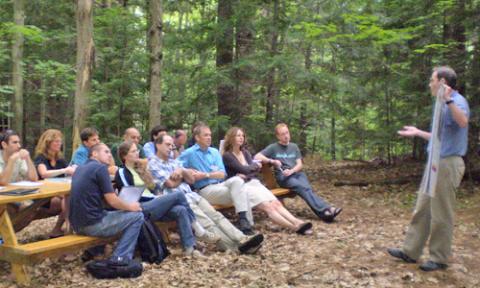Controls of Catchment Response to Anthropogenic Nitrogen Deposition: A Trans-Atlantic Synthesis

Atmospheric nitrogen deposition can have a range of adverse consequences for ecosystems, often marked by increased nitrate loss in drainage waters. Nitrate is a form of nitrogen that is produced by microorganisms when there is an abundance of biologically available nitrogen. However, this process acidifies soils, and nitrate leaching or loss from soil contributes to stream acidification. Nitrate losses can be difficult to predict, and many factors affect nitrogen retention.
In the Nitrogen Retention across Europe and eastern North America (NiRENA) project, NSRC researchers examined patterns and controls of nitrogen retention across temperate ecosystems receiving elevated nitrogen deposition from air pollution. Starting with a 2-day workshop in Durham, New Hampshire, researchers assembled a dataset of 327 plot- and catchment-scale measurements of nitrogen inputs and losses for forest and heathland sites across northeastern North America and western Europe. They also assembled supplementary information on site vegetation, soils, and climate.
Data indicate that both European and North American ecosystems have a nitrate "threshold" response: ecosystems retained almost all nitrogen from deposition until deposition rates reached eight kilograms of nitrogen per hectare per year. Above this threshold, losses of both nitrate and dissolved organic forms of nitrogen increased steadily with nitrogen inputs. Nitrate loss increased more abruptly in forest ecosystems than in heathlands of the United Kingdom in which nitrate export may be slowed by partial conversion to dissolved organic nitrogen.
